Exploring Cultural Identity and Intercultural Relations in Business
VerifiedAdded on 2023/06/05
|7
|2185
|86
Essay
AI Summary
This essay delves into the intricate relationship between cultural identity and nationality within the context of international business. It emphasizes the importance of understanding one's own culture and appreciating cultural differences to foster effective communication and collaboration. The discussion covers essential skills for managers in intercultural communication, such as awareness of cultural nuances, body language interpretation, and active listening. It also addresses the complexities arising from language barriers and prejudices, highlighting the need for tolerance and continuous learning to navigate the global business environment successfully. The essay uses examples like Starbucks to illustrate how a company's cultural identity, rooted in its nationality, influences its business strategies and market expansion.
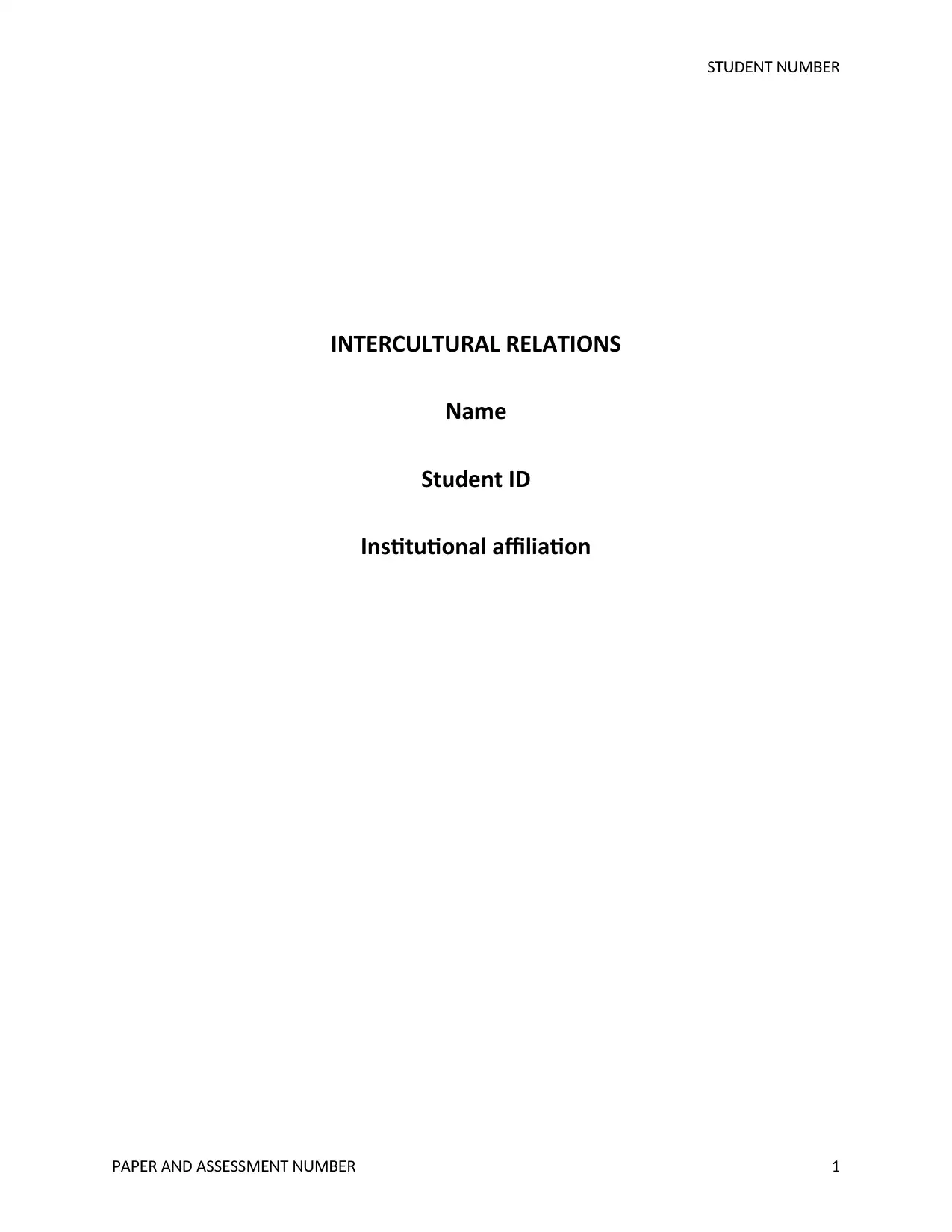
S D M RTU ENT NU BE
INTERCULTURAL RELATIONS
Name
Student ID
Institutional affiliation
A R A D ASS SSM M RP PE N E ENT NU BE 1
INTERCULTURAL RELATIONS
Name
Student ID
Institutional affiliation
A R A D ASS SSM M RP PE N E ENT NU BE 1
Secure Best Marks with AI Grader
Need help grading? Try our AI Grader for instant feedback on your assignments.
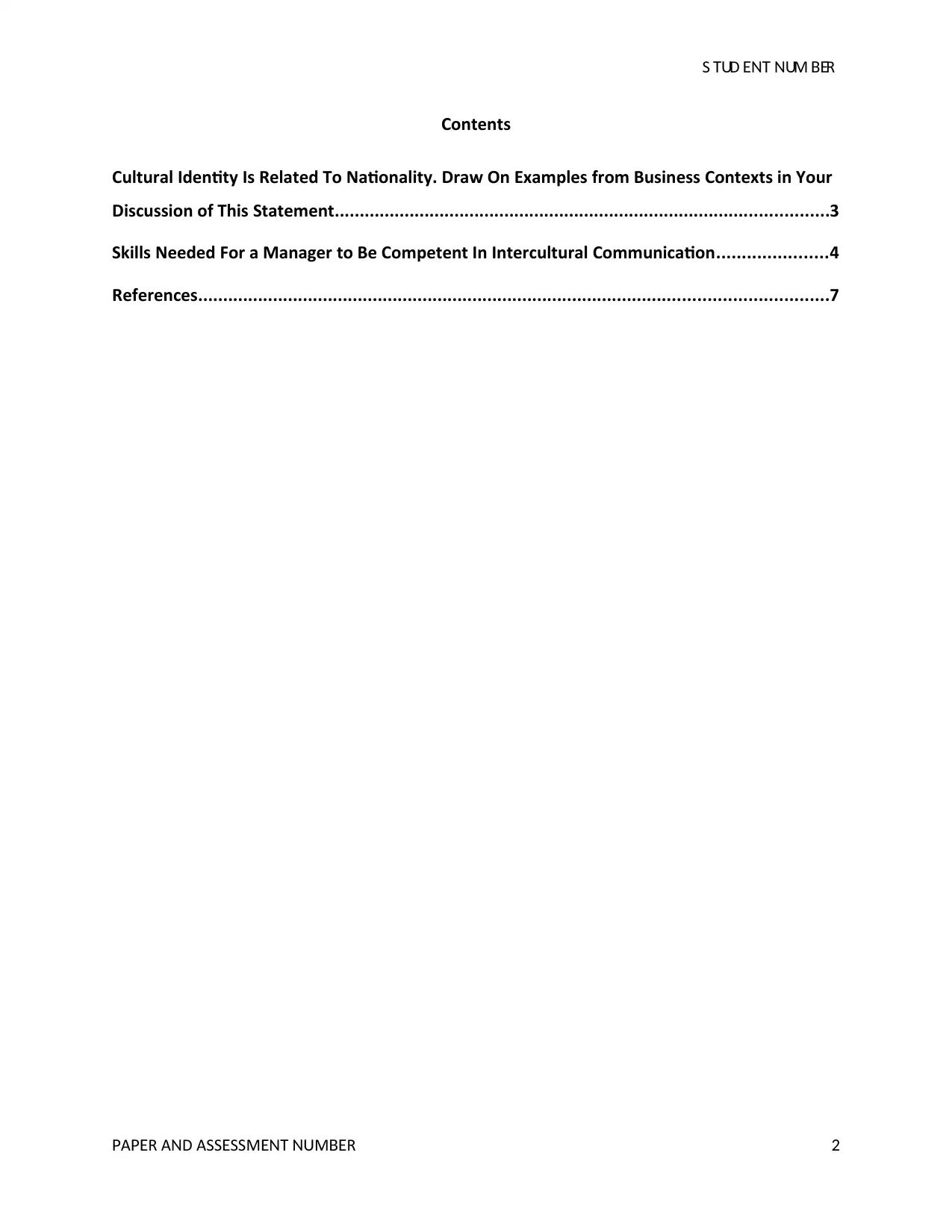
S D M RTU ENT NU BE
Contents
Cultural Identity Is Related To Nationality. Draw On Examples from Business Contexts in Your
Discussion of This Statement...................................................................................................3
Skills Needed For a Manager to Be Competent In Intercultural Communication......................4
References..............................................................................................................................7
A R A D ASS SSM M RP PE N E ENT NU BE 2
Contents
Cultural Identity Is Related To Nationality. Draw On Examples from Business Contexts in Your
Discussion of This Statement...................................................................................................3
Skills Needed For a Manager to Be Competent In Intercultural Communication......................4
References..............................................................................................................................7
A R A D ASS SSM M RP PE N E ENT NU BE 2
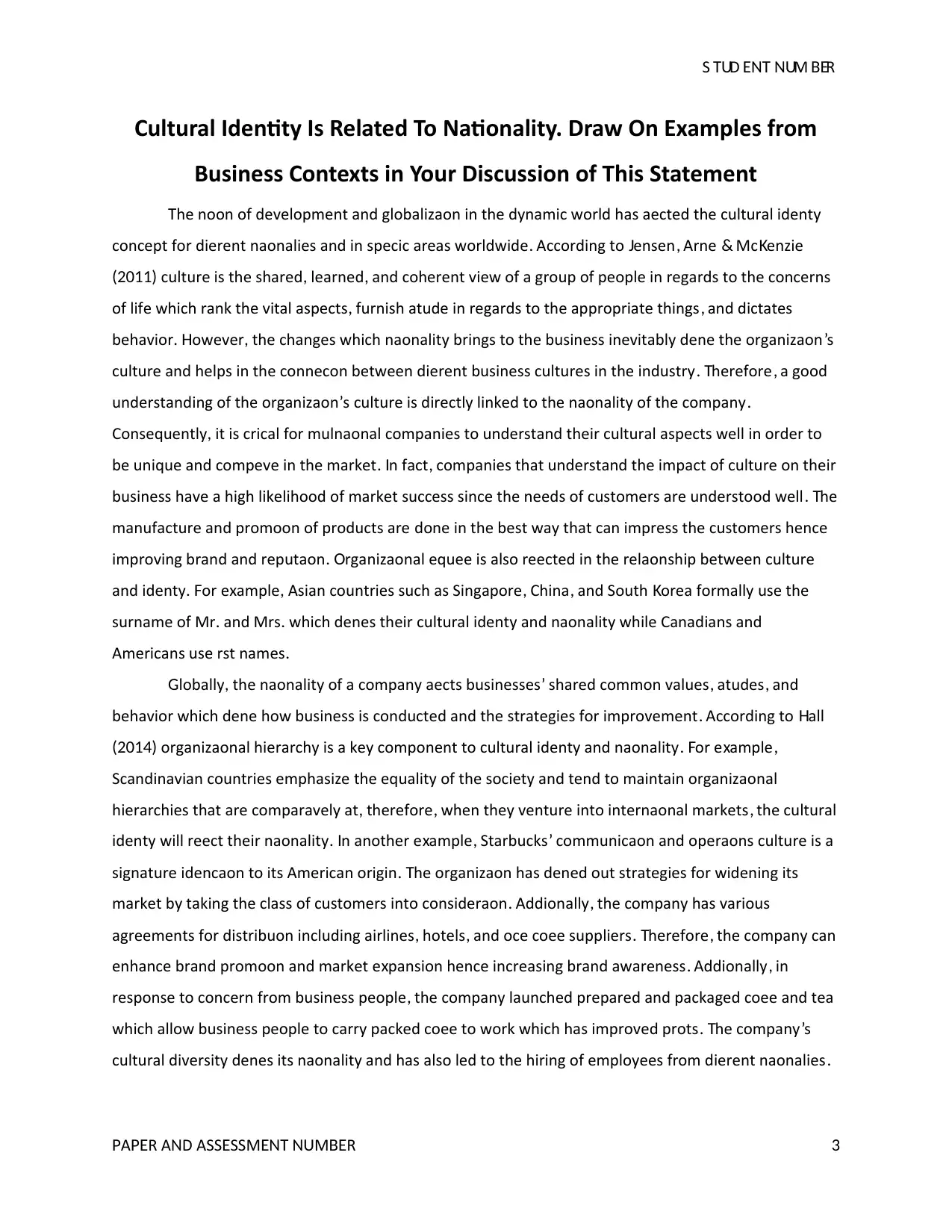
S D M RTU ENT NU BE
Cultural Identity Is Related To Nationality. Draw On Examples from
Business Contexts in Your Discussion of This Statement
he notion of development and globalization in the dynamic world has affected the cultural identityT
concept for different nationalities and in specific areas worldwide According to ensen Arnett Mc enzie. J , & K
culture is the shared learned and coherent view of a group of people in regards to the concerns(2011) , ,
of life which rank the vital aspects furnish attitude in regards to the appropriate things and dictates, ,
behavior owever the changes which nationality brings to the business inevitably define the organization s. H , ’
culture and helps in the connection between different business cultures in the industry herefore a good. T ,
understanding of the organization s culture is directly linked to the nationality of the company’ .
Consequently it is critical for multinational companies to understand their cultural aspects well in order to,
be unique and competitive in the market n fact companies that understand the impact of culture on their. I ,
business have a high likelihood of market success since the needs of customers are understood well he. T
manufacture and promotion of products are done in the best way that can impress the customers hence
improving brand and reputation rganizational etiquette is also reflected in the relationship between culture. O
and identity or e ample Asian countries such as Singapore China and South orea formally use the. F x , , , K
surname of Mr and Mrs which defines their cultural identity and nationality while Canadians and. .
Americans use fi rst names.
lobally the nationality of a company affects businesses shared common values attitudes andG , ’ , ,
behavior which define how business is conducted and the strategies for improvement According to all. H
organizational hierarchy is a key component to cultural identity and nationality or e ample(2014) . F x ,
Scandinavian countries emphasize the equality of the society and tend to maintain organizational
hierarchies that are comparatively fl at therefore when they venture into international markets the cultural, , ,
identity will reflect their nationality n another e ample Starbucks communication and operations culture is a. I x , ’
signature identification to its American origin he organization has defined out strategies for widening its. T
market by taking the class of customers into consideration Additionally the company has various. ,
agreements for distribution including airlines hotels and office coffee suppliers herefore the company can, , . T ,
enhance brand promotion and market e pansion hence increasing brand awareness Additionally inx . ,
response to concern from business people the company launched prepared and packaged coffee and tea,
which allow business people to carry packed coffee to work which has improved profits he company s. T ’
cultural diversity defines its nationality and has also led to the hiring of employees from different nationalities.
A R A D ASS SSM M RP PE N E ENT NU BE 3
Cultural Identity Is Related To Nationality. Draw On Examples from
Business Contexts in Your Discussion of This Statement
he notion of development and globalization in the dynamic world has affected the cultural identityT
concept for different nationalities and in specific areas worldwide According to ensen Arnett Mc enzie. J , & K
culture is the shared learned and coherent view of a group of people in regards to the concerns(2011) , ,
of life which rank the vital aspects furnish attitude in regards to the appropriate things and dictates, ,
behavior owever the changes which nationality brings to the business inevitably define the organization s. H , ’
culture and helps in the connection between different business cultures in the industry herefore a good. T ,
understanding of the organization s culture is directly linked to the nationality of the company’ .
Consequently it is critical for multinational companies to understand their cultural aspects well in order to,
be unique and competitive in the market n fact companies that understand the impact of culture on their. I ,
business have a high likelihood of market success since the needs of customers are understood well he. T
manufacture and promotion of products are done in the best way that can impress the customers hence
improving brand and reputation rganizational etiquette is also reflected in the relationship between culture. O
and identity or e ample Asian countries such as Singapore China and South orea formally use the. F x , , , K
surname of Mr and Mrs which defines their cultural identity and nationality while Canadians and. .
Americans use fi rst names.
lobally the nationality of a company affects businesses shared common values attitudes andG , ’ , ,
behavior which define how business is conducted and the strategies for improvement According to all. H
organizational hierarchy is a key component to cultural identity and nationality or e ample(2014) . F x ,
Scandinavian countries emphasize the equality of the society and tend to maintain organizational
hierarchies that are comparatively fl at therefore when they venture into international markets the cultural, , ,
identity will reflect their nationality n another e ample Starbucks communication and operations culture is a. I x , ’
signature identification to its American origin he organization has defined out strategies for widening its. T
market by taking the class of customers into consideration Additionally the company has various. ,
agreements for distribution including airlines hotels and office coffee suppliers herefore the company can, , . T ,
enhance brand promotion and market e pansion hence increasing brand awareness Additionally inx . ,
response to concern from business people the company launched prepared and packaged coffee and tea,
which allow business people to carry packed coffee to work which has improved profits he company s. T ’
cultural diversity defines its nationality and has also led to the hiring of employees from different nationalities.
A R A D ASS SSM M RP PE N E ENT NU BE 3
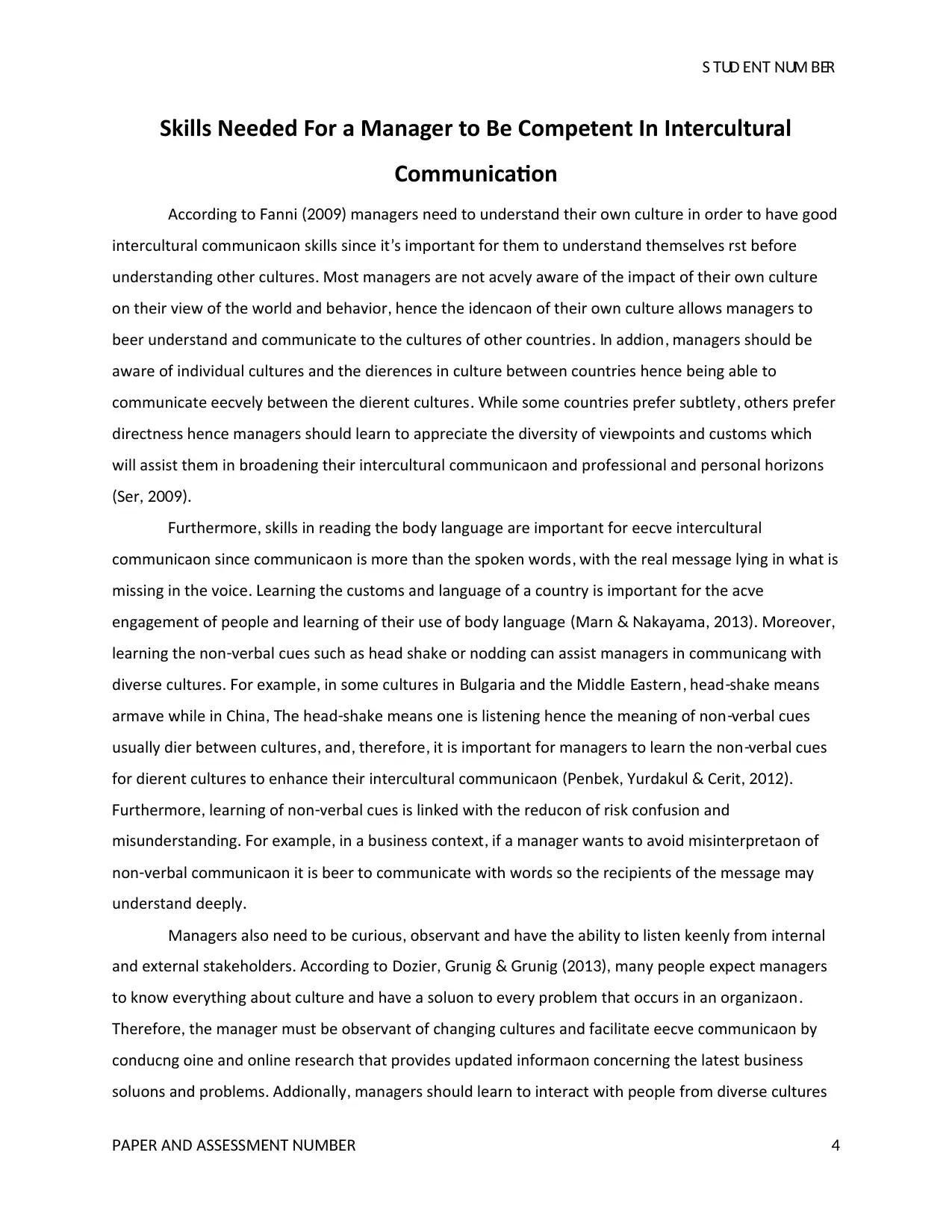
S D M RTU ENT NU BE
Skills Needed For a Manager to Be Competent In Intercultural
Communication
According to antini managers need to understand their own culture in order to have goodF (2009)
intercultural communication skills since it s important for them to understand themselves fi rst before’
understanding other cultures Most managers are not actively aware of the impact of their own culture.
on their view of the world and behavior hence the identification of their own culture allows managers to,
better understand and communicate to the cultures of other countries n addition managers should be. I ,
aware of individual cultures and the differences in culture between countries hence being able to
communicate effectively between the different cultures hile some countries prefer subtlety others prefer. W ,
directness hence managers should learn to appreciate the diversity of viewpoints and customs which
will assist them in broadening their intercultural communication and professional and personal horizons
Stier( , 2009).
urthermore skills in reading the body language are important for effective interculturalF ,
communication since communication is more than the spoken words with the real message lying in what is,
missing in the voice earning the customs and language of a country is important for the active. L
engagement of people and learning of their use of body language (Martin akayama& N , 2013) Moreover. ,
learning the non verbal cues such as head shake or nodding can assist managers in communicating with-
diverse cultures or e ample in some cultures in ulgaria and the Middle astern head shake means. F x , B E , -
affirmative while in China he head shake means one is listening hence the meaning of non verbal cues, T - -
usually differ between cultures and therefore it is important for managers to learn the non verbal cues, , , -
for different cultures to enhance their intercultural communication ( enbek urdakul CeritP , Y & , 2012).
urthermore learning of non verbal cues is linked with the reduction of risk confusion andF , -
misunderstanding or e ample in a business conte t if a manager wants to avoid misinterpretation of. F x , x ,
non verbal communication it is better to communicate with words so the recipients of the message may-
understand deeply.
Managers also need to be curious observant and have the ability to listen keenly from internal,
and e ternal stakeholders According tox . Dozier runig runig, G & G (2013), many people e pect managersx
to know everything about culture and have a solution to every problem that occurs in an organization .
herefore the manager must be observant of changing cultures and facilitate effective communication byT ,
conducting offline and online research that provides updated information concerning the latest business
solutions and problems Additionally managers should learn to interact with people from diverse cultures. ,
A R A D ASS SSM M RP PE N E ENT NU BE 4
Skills Needed For a Manager to Be Competent In Intercultural
Communication
According to antini managers need to understand their own culture in order to have goodF (2009)
intercultural communication skills since it s important for them to understand themselves fi rst before’
understanding other cultures Most managers are not actively aware of the impact of their own culture.
on their view of the world and behavior hence the identification of their own culture allows managers to,
better understand and communicate to the cultures of other countries n addition managers should be. I ,
aware of individual cultures and the differences in culture between countries hence being able to
communicate effectively between the different cultures hile some countries prefer subtlety others prefer. W ,
directness hence managers should learn to appreciate the diversity of viewpoints and customs which
will assist them in broadening their intercultural communication and professional and personal horizons
Stier( , 2009).
urthermore skills in reading the body language are important for effective interculturalF ,
communication since communication is more than the spoken words with the real message lying in what is,
missing in the voice earning the customs and language of a country is important for the active. L
engagement of people and learning of their use of body language (Martin akayama& N , 2013) Moreover. ,
learning the non verbal cues such as head shake or nodding can assist managers in communicating with-
diverse cultures or e ample in some cultures in ulgaria and the Middle astern head shake means. F x , B E , -
affirmative while in China he head shake means one is listening hence the meaning of non verbal cues, T - -
usually differ between cultures and therefore it is important for managers to learn the non verbal cues, , , -
for different cultures to enhance their intercultural communication ( enbek urdakul CeritP , Y & , 2012).
urthermore learning of non verbal cues is linked with the reduction of risk confusion andF , -
misunderstanding or e ample in a business conte t if a manager wants to avoid misinterpretation of. F x , x ,
non verbal communication it is better to communicate with words so the recipients of the message may-
understand deeply.
Managers also need to be curious observant and have the ability to listen keenly from internal,
and e ternal stakeholders According tox . Dozier runig runig, G & G (2013), many people e pect managersx
to know everything about culture and have a solution to every problem that occurs in an organization .
herefore the manager must be observant of changing cultures and facilitate effective communication byT ,
conducting offline and online research that provides updated information concerning the latest business
solutions and problems Additionally managers should learn to interact with people from diverse cultures. ,
A R A D ASS SSM M RP PE N E ENT NU BE 4
Secure Best Marks with AI Grader
Need help grading? Try our AI Grader for instant feedback on your assignments.

S D M RTU ENT NU BE
as a way of equipping observation and listen to skills as people have different ways of doing things.
ickman SilvaH & (2018) stated that if a manager stays inquisitive and open and shows genuine interest in“
others people s cultures people will always appreciate and remain happy urthermore by observing’ , ”. F ,
how people use gestures and talk a manager can feel how communication fl ows, .
Managers should have simplicity skills which make people from all cultures feel free as they
address their concerns or e ample when the manager is communicating with people whose native. F x ,
language is not nglish it is better for him to avoid acronyms or difficult idioms abbreviations and slangE , ,
words as it is the tendency of people to learn languages slowly and not familiar with colloquial phrases .
According to uinliskQ (2009) high conte t cultures like the SA the meaning is conveyed and- x U ,
interpreted by verbal communication means like spoken words while in apan meaning is interpreted byJ
non verbal communications methods like pauses and meetings rephrasing of the words and body- ,
language.
Discuss the Complexity of Intercultural Business Communication
anguage contributes to the interaction that e ists between identities and cultures and helps in theL x
construction of identities and cultures n the conte t of international business the workplace has remained. I x ,
contingent and hybrid because of intercultural business communication comple ities between parties fromx
diverse cultures due to language barriers he concept of identity and culture are transformational hybrid. T ,
and fl uid and therefore they undergo transformation through interaction and practices Sharifian. (2013)
termed language as a central vehicle of culture while ennycook argued that comple ity of“ ” P (2017) x
cultural identity in business is negotiated through communication and it includes languages and its users and
conte t of communication occurrence urthermore the language that is currently used in businessx . F ,
communication is not a neutral tool as the world believes it is but instead its vehicle and the culture
carrier nglish which is regarded as the lingua franca of international business had been a contributed to. E
the growth of culture and identity through communication erraro riody stated that nglish is. F & B (2013) “E
culturally shaped and that this has philosophical consequences for modern world globalization and the
nglish dominated worldE - ”.
Additionally participants and conte ts are essential elements for the transformation and composition, x
of culture and identity in business and international relations f these components are not incorporated the. I ,
intercultural comple ities can result in ideological differences between the business co partners Recentx - .
research by arzing eelyH & F (2008) touching the areas of workplace practice and management cross, -
cultural communication culture and identity has further shown that dynamic cultural fl uid nature and, ,
A R A D ASS SSM M RP PE N E ENT NU BE 5
as a way of equipping observation and listen to skills as people have different ways of doing things.
ickman SilvaH & (2018) stated that if a manager stays inquisitive and open and shows genuine interest in“
others people s cultures people will always appreciate and remain happy urthermore by observing’ , ”. F ,
how people use gestures and talk a manager can feel how communication fl ows, .
Managers should have simplicity skills which make people from all cultures feel free as they
address their concerns or e ample when the manager is communicating with people whose native. F x ,
language is not nglish it is better for him to avoid acronyms or difficult idioms abbreviations and slangE , ,
words as it is the tendency of people to learn languages slowly and not familiar with colloquial phrases .
According to uinliskQ (2009) high conte t cultures like the SA the meaning is conveyed and- x U ,
interpreted by verbal communication means like spoken words while in apan meaning is interpreted byJ
non verbal communications methods like pauses and meetings rephrasing of the words and body- ,
language.
Discuss the Complexity of Intercultural Business Communication
anguage contributes to the interaction that e ists between identities and cultures and helps in theL x
construction of identities and cultures n the conte t of international business the workplace has remained. I x ,
contingent and hybrid because of intercultural business communication comple ities between parties fromx
diverse cultures due to language barriers he concept of identity and culture are transformational hybrid. T ,
and fl uid and therefore they undergo transformation through interaction and practices Sharifian. (2013)
termed language as a central vehicle of culture while ennycook argued that comple ity of“ ” P (2017) x
cultural identity in business is negotiated through communication and it includes languages and its users and
conte t of communication occurrence urthermore the language that is currently used in businessx . F ,
communication is not a neutral tool as the world believes it is but instead its vehicle and the culture
carrier nglish which is regarded as the lingua franca of international business had been a contributed to. E
the growth of culture and identity through communication erraro riody stated that nglish is. F & B (2013) “E
culturally shaped and that this has philosophical consequences for modern world globalization and the
nglish dominated worldE - ”.
Additionally participants and conte ts are essential elements for the transformation and composition, x
of culture and identity in business and international relations f these components are not incorporated the. I ,
intercultural comple ities can result in ideological differences between the business co partners Recentx - .
research by arzing eelyH & F (2008) touching the areas of workplace practice and management cross, -
cultural communication culture and identity has further shown that dynamic cultural fl uid nature and, ,
A R A D ASS SSM M RP PE N E ENT NU BE 5
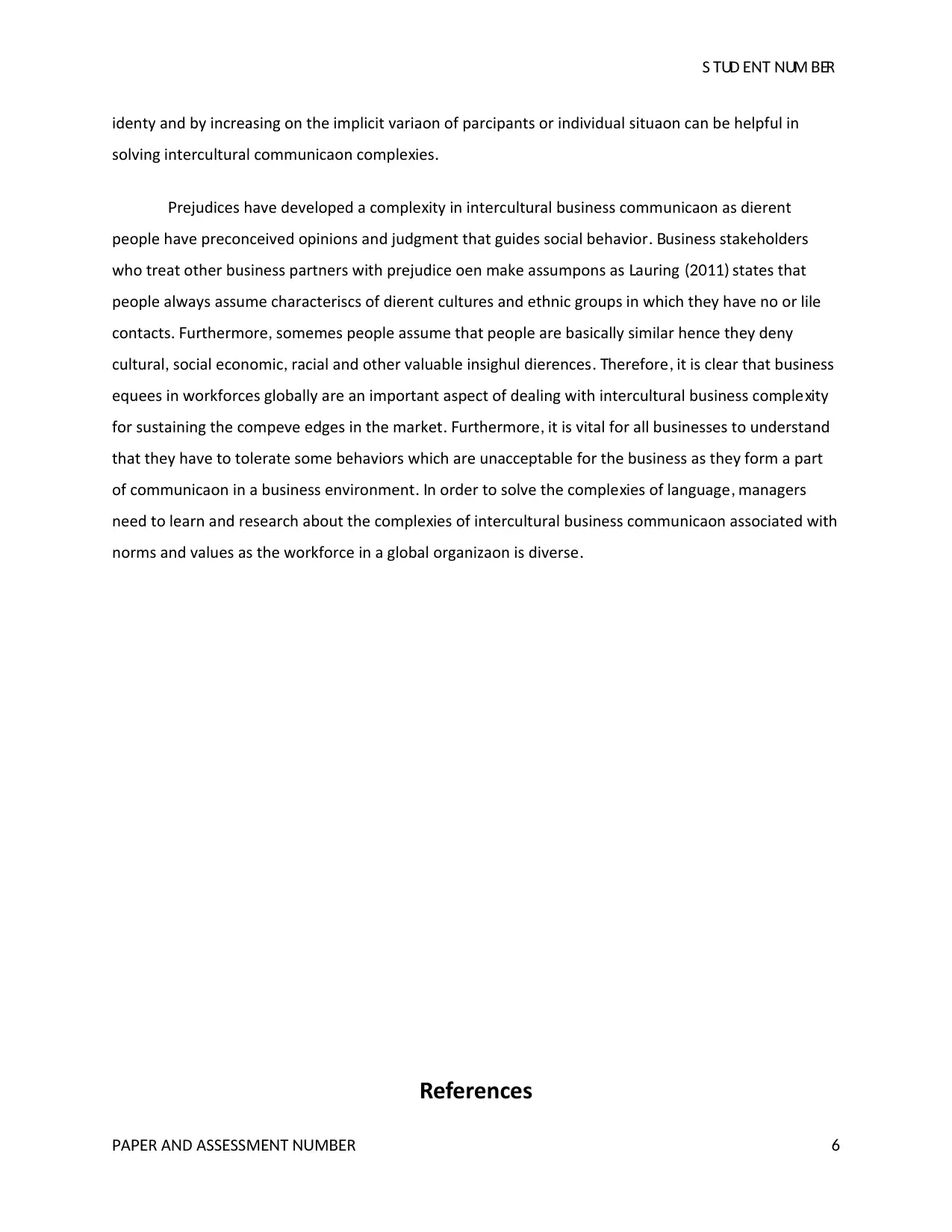
S D M RTU ENT NU BE
identity and by increasing on the implicit variation of participants or individual situation can be helpful in
solving intercultural communication comple itiesx .
rejudices have developed a comple ity in intercultural business communication as differentP x
people have preconceived opinions and judgment that guides social behavior usiness stakeholders. B
who treat other business partners with prejudice often make assumptions as auring states thatL (2011)
people always assume characteristics of different cultures and ethnic groups in which they have no or little
contacts urthermore sometimes people assume that people are basically similar hence they deny. F ,
cultural social economic racial and other valuable insightful differences herefore it is clear that business, , . T ,
etiquettes in workforces globally are an important aspect of dealing with intercultural business comple ityx
for sustaining the competitive edges in the market urthermore it is vital for all businesses to understand. F ,
that they have to tolerate some behaviors which are unacceptable for the business as they form a part
of communication in a business environment n order to solve the comple ities of language managers. I x ,
need to learn and research about the comple ities of intercultural business communication associated withx
norms and values as the workforce in a global organization is diverse .
References
A R A D ASS SSM M RP PE N E ENT NU BE 6
identity and by increasing on the implicit variation of participants or individual situation can be helpful in
solving intercultural communication comple itiesx .
rejudices have developed a comple ity in intercultural business communication as differentP x
people have preconceived opinions and judgment that guides social behavior usiness stakeholders. B
who treat other business partners with prejudice often make assumptions as auring states thatL (2011)
people always assume characteristics of different cultures and ethnic groups in which they have no or little
contacts urthermore sometimes people assume that people are basically similar hence they deny. F ,
cultural social economic racial and other valuable insightful differences herefore it is clear that business, , . T ,
etiquettes in workforces globally are an important aspect of dealing with intercultural business comple ityx
for sustaining the competitive edges in the market urthermore it is vital for all businesses to understand. F ,
that they have to tolerate some behaviors which are unacceptable for the business as they form a part
of communication in a business environment n order to solve the comple ities of language managers. I x ,
need to learn and research about the comple ities of intercultural business communication associated withx
norms and values as the workforce in a global organization is diverse .
References
A R A D ASS SSM M RP PE N E ENT NU BE 6
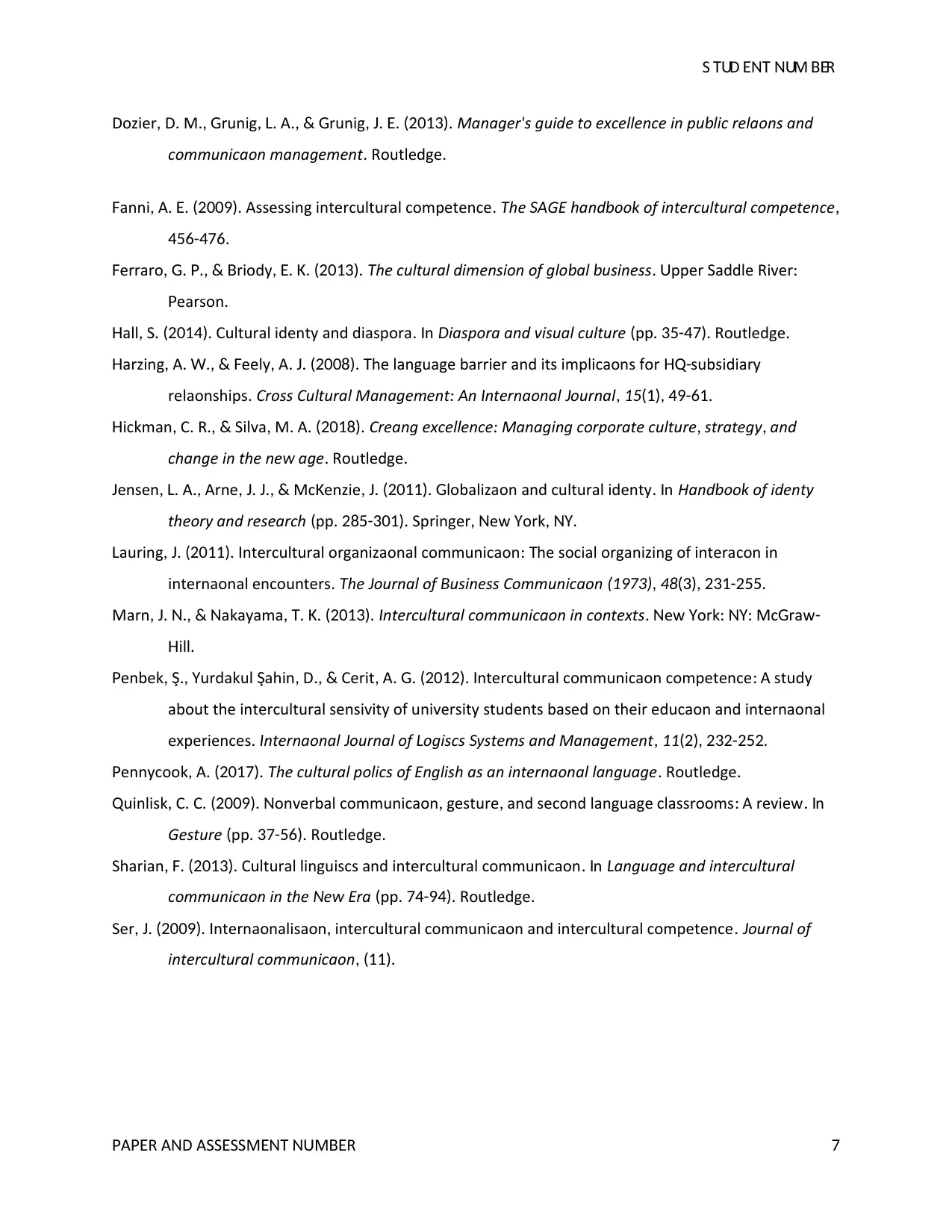
S D M RTU ENT NU BE
Dozier D M runig A runig, . ., G , L. ., & G , J. E. (2013). Manager s guide to excellence in pu lic relations and' b
communication management Routledge. .
antini A Assessing intercultural competenceF , . E. (2009). . he GE hand oo of intercultural competenceT SA b k ,
456-476.
erraro riodyF , G. P., & B , E. K. (2013). he cultural dimension of glo al usinessT b b pper Saddle River. U :
earsonP .
all S Cultural identity and diaspora nH , . (2014). . I iaspora and visual cultureD pp Routledge( . 35-47). .
arzing A eely A he language barrier and its implications for subsidiaryH , . W., & F , . J. (2008). T HQ-
relationships. Cross Cultural Management n nternational ournal: A I J , 15(1), 49-61.
ickman C R Silva M AH , . ., & , . . (2018). Creating excellence Managing corporate culture strategy and: , ,
change in the ne agew Routledge. .
ensen A Arnett Mc enzie lobalization and cultural identity nJ , L. ., , J. J., & K , J. (2011). G . I Hand oo of identityb k
theory and research pp Springer ew ork( . 285-301). , N Y , NY.
auring ntercultural organizational communication he social organizing of interaction inL , J. (2011). I : T
international encounters. he ournal of usiness CommunicationT J B (1973), 48(3), 231-255.
Martin akayama, J. N., & N , T. K. (2013). ntercultural communication in contextsI ew ork Mc raw. N Y : NY: G -
illH .
enbek urdakul ahin D Cerit A ntercultural communication competence A studyP , Ş., Y Ş , ., & , . G. (2012). I :
about the intercultural sensitivity of university students based on their education and international
e periencesx . nternational ournal of ogistics ystems and ManagementI J L S , 11(2), 232-252.
ennycook AP , . (2017). he cultural politics of English as an international languageT Routledge. .
uinlisk C C onverbal communication gesture and second language classrooms A review nQ , . . (2009). N , , : . I
Gesture pp Routledge( . 37-56). .
Sharifian Cultural linguistics and intercultural communication n, F. (2013). . I anguage and interculturalL
communication in the e EraN w pp Routledge( . 74-94). .
Stier nternationalisation intercultural communication and intercultural competence, J. (2009). I , . ournal ofJ
intercultural communication, (11).
A R A D ASS SSM M RP PE N E ENT NU BE 7
Dozier D M runig A runig, . ., G , L. ., & G , J. E. (2013). Manager s guide to excellence in pu lic relations and' b
communication management Routledge. .
antini A Assessing intercultural competenceF , . E. (2009). . he GE hand oo of intercultural competenceT SA b k ,
456-476.
erraro riodyF , G. P., & B , E. K. (2013). he cultural dimension of glo al usinessT b b pper Saddle River. U :
earsonP .
all S Cultural identity and diaspora nH , . (2014). . I iaspora and visual cultureD pp Routledge( . 35-47). .
arzing A eely A he language barrier and its implications for subsidiaryH , . W., & F , . J. (2008). T HQ-
relationships. Cross Cultural Management n nternational ournal: A I J , 15(1), 49-61.
ickman C R Silva M AH , . ., & , . . (2018). Creating excellence Managing corporate culture strategy and: , ,
change in the ne agew Routledge. .
ensen A Arnett Mc enzie lobalization and cultural identity nJ , L. ., , J. J., & K , J. (2011). G . I Hand oo of identityb k
theory and research pp Springer ew ork( . 285-301). , N Y , NY.
auring ntercultural organizational communication he social organizing of interaction inL , J. (2011). I : T
international encounters. he ournal of usiness CommunicationT J B (1973), 48(3), 231-255.
Martin akayama, J. N., & N , T. K. (2013). ntercultural communication in contextsI ew ork Mc raw. N Y : NY: G -
illH .
enbek urdakul ahin D Cerit A ntercultural communication competence A studyP , Ş., Y Ş , ., & , . G. (2012). I :
about the intercultural sensitivity of university students based on their education and international
e periencesx . nternational ournal of ogistics ystems and ManagementI J L S , 11(2), 232-252.
ennycook AP , . (2017). he cultural politics of English as an international languageT Routledge. .
uinlisk C C onverbal communication gesture and second language classrooms A review nQ , . . (2009). N , , : . I
Gesture pp Routledge( . 37-56). .
Sharifian Cultural linguistics and intercultural communication n, F. (2013). . I anguage and interculturalL
communication in the e EraN w pp Routledge( . 74-94). .
Stier nternationalisation intercultural communication and intercultural competence, J. (2009). I , . ournal ofJ
intercultural communication, (11).
A R A D ASS SSM M RP PE N E ENT NU BE 7
1 out of 7
Related Documents
Your All-in-One AI-Powered Toolkit for Academic Success.
+13062052269
info@desklib.com
Available 24*7 on WhatsApp / Email
![[object Object]](/_next/static/media/star-bottom.7253800d.svg)
Unlock your academic potential
© 2024 | Zucol Services PVT LTD | All rights reserved.




